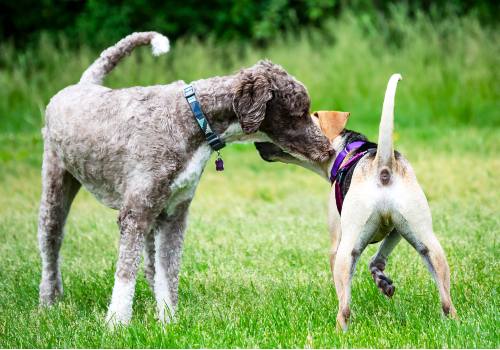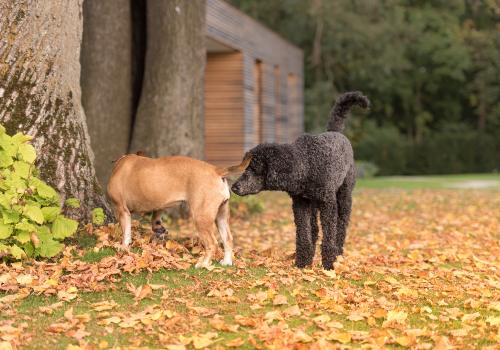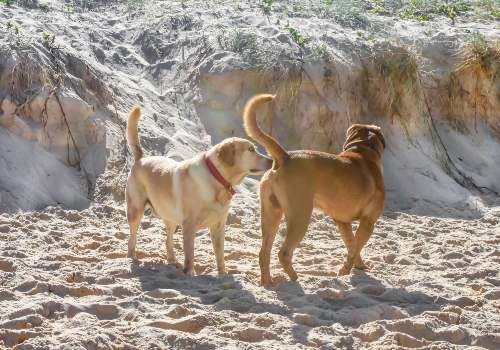What’s in a greeting? A warm smile, a happy wave, a genuine handshake… or, if you’re a dog, a hearty sniff of your new acquaintance’s rear end.
Of all the strange canine behaviors that dog owners witness, butt sniffing has got to be one of the weirdest — and grossest. But clearly, it has some benefit for our furry friends because they never seem to tire of doing it.
So why do dogs smell each other’s butts? Hold your nose — we’re about to find out!
Smell: The Secret to Your Pup’s Perception
Before we get into the places your dog sticks his nose, let’s take a look inside this fascinating organ and see how it works.
Dependent on Scent
We’re all familiar with the five senses: touch, smell, taste, hearing, and sight.
For most of us humans, sight is the most powerful sense — the one we rely on most to take in information about the world around us. We’re able to see fine details and vibrant colors, track moving objects, and focus our eyes to different depths.
But dogs’ eyes aren’t as refined as ours. Visually, the world appears to them like an assortment of blurs with a limited color palette.
That’s OK, though, because their noses are there to pick up the slack.
A dog’s sense of smell is thought to be 100,000 times stronger than ours. They can smell absolutely everything, even things that we perceive to have no smell at all — and through scent, they can discern qualities that we rely on our eyes to perceive, such as distance and size.
Olfactory Anatomy

Noses work by capturing scent molecules with special cells called olfactory receptors. These receptors translate the chemicals that comprise the scent into biological signals that can be sent via nerves to the brain for processing.
We get by with around 5 million olfactory receptors, which sounds like it should be plenty. But in practice, it’s a low enough quantity that our noses can’t pick up light or distant odors — and they can easily get overwhelmed by heavy, dense scents.
A dog’s nose, on the other hand, contains upwards of 150 million olfactory receptors, enabling the detection of faint, far away smells. Plus, it’s wet, and that moisture helps trap more scent molecules than our relatively dry noses.
And it’s not just the nose that gives dogs their amazing sense of smell. They also have a special organ between the mouth and the nose called Jacobson’s organ, and it’s responsible for detecting the scent of things that have no odor.
It sounds oxymoronic, but it’s true: living things produce pheromones and other chemicals that are technically unscented, but are still processed through the olfactory system. These carry information like health status, mating status, age, and even mood.
Since we lack our own Jacobson’s organs, this world of “undetectable scents” is inaccessible to us. But it’s a critical bridge between dogs and the physical world, giving them access to information they couldn’t otherwise perceive.
How the Brain Decodes Odors
The first stop that scent signals make once they reach the brain is the olfactory bulb. This part of the brain acts as a receptionist, routing the signals to other parts of the brain for further processing.
From there, many different brain structures analyze the scent in various ways. The piriform cortex, for instance, identifies the smell, while the orbitofrontal cortex integrates the smell information with taste information.
And the hippocampus and amygdala spring into action as well, referencing your memory bank to see if the smell is familiar, then conjuring the appropriate emotional response.
Altogether, the neurons involved in processing scent makeup around 5% of the human brain.
But they make up around 30% of the canine brain.
Yes, nearly a third of your dog’s brainpower is devoted to smell. Which brings us back to the matter of butt sniffing…
Canine Communication: Talk to the Butt!

Given their incredible sense of smell, it makes sense that dogs would use scents to learn about and communicate with one another.
And that’s exactly what they’re doing when they sniff each other’s butts. Without advanced language or precision eyesight, odors are the best option they have for introducing themselves.
But why butts specifically?
Let’s return for a moment to the topic of pheromones — the chemicals that dogs use to absorb information about one another. They’re secreted in saliva and urine, but the strongest ones come from two little sacs located near the anus.
Unfortunately for us, these anal glands don’t just produce pheromones. They also produce an oily, musty liquid that’s excreted when a dog poops — and that’s responsible for much of the poop’s nasty scent.
Though we find it noxious, many dogs seem to genuinely enjoy the scent of this fluid, or at least find it compelling enough to continue taking whiffs.
But their drive to sniff butts goes beyond the pursuit of sensory pleasure. When combined, the pheromones and anal gland fluids serve as an autobiography of sorts — one that dogs rely on to get to know each other.
Filling Out the Pheromone Profile
Both the pheromones and the anal gland fluids are unique to each individual dog. They carry all sorts of information, like the canine equivalent of a Facebook profile.
We still don’t know the full extent of the information your dog’s butt conveys, but what we do know is quite impressive! Here are just some of the things your dog’s butt reveals to the world.
Age
Many people say they can smell the difference between a puppy and an adult dog, even with our pitiful noses.
If we’re capable of that, imagine what a dog can pick up on!
Your dog’s pheromones will change throughout his life, from puppy to adult to senior. They’re the easiest, most reliable way for other dogs to pinpoint his age — and behave accordingly.
Breeding Status

If your dog isn’t spayed or neutered, he or she will feel compelled to reproduce. And thanks to pheromones, finding someone to reproduce with is as easy as sniffing a few butts.
Female dogs in heat smell different from other females, and male dogs in their sexual prime smell different from those who are past it. No need to waste time getting to know someone who’s not interested — sexually frustrated dogs just need to follow their noses.
Health
Dogs with diabetes, digestive issues, and many other health conditions can smell quite different than others, even to our unrefined noses.
And if you could smell like your dog can… well, you’d never need to go to a vet to diagnose his health problems again.
The smell of your dog’s butt tells other dogs whether or not he’s sick — and, by connection, whether or not to stay away from him, lest he be contagious. It’s no doubt proven handy over the past few million years of evolution when that olfactory prowess could have meant the difference between life or death.
Mood
We typically rely on facial expressions to determine one another’s mood. But when your dog needs to figure out how another dog is feeling, he relies on the opposite end: the butt.
The chemical compounds found in anal gland fluid vary based on the hormones coursing through a dog’s body. And those hormones vary based on the dog’s mood — serotonin for happiness, dopamine for excitement, cortisol for stress, adrenaline for anxiety, and many more.
Through this hormonal alchemy, dogs can effortlessly communicate to others how they’re feeling. Who knew the butt was so instrumental to canine empathy?
Butt-Sniffing Etiquette
Believe it or not, there’s an unspoken code of politeness to canine butt-sniffing. Observing how your dog choreographs his sniffing sessions can clue you into his social standing and confidence.
Typically, the dog who’s more dominant — or who sees himself as more dominant — will initiate the sniffing. If the other dog doesn’t assume the submissive role and wait his turn, the dominant dog may start growling and revoke butt-sniffing privileges.
On the other hand, a submissive dog will often stop sniffing early on, signaling awareness of his place in the hierarchy.
And if he’s fearful of his dominant acquaintance, he may hold his tail between his legs — both to protect it from potential injury in a fight and to reduce the odor coming from his butt. Wouldn’t you want your enemies to know as little about you as possible, too?
The Bottom Line
First impressions are everything, and that’s true for both humans and dogs.
So while you may get grossed out or impatient when your dog pauses your walk to sniff the neighbor’s pup’s butt, don’t try to stop him and try not to rush him.
He’s performing the most basic canine social interaction: the “Hi! How are you!” of the dog world. And a successful sniffing session is the foundation of a future friendship.
By taking one sniff of another dog’s butt, your dog gets an incredibly detailed snapshot of the newcomer’s identity. And he stores that snapshot in his memory so that the next time the two encounter each other, no introductions are necessary.
